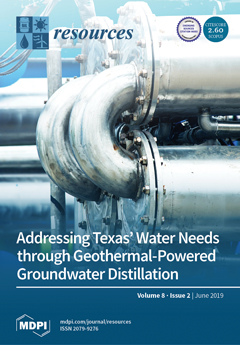Dental and emaciated fluorosis is derived from the chronic intake of fluoride ions (F
−) by consumption of food, tooth products and drinking water from groundwater. Recent reports indicate that in some regions of Mexico, the incidence of fluorosis in temporary and
[...] Read more.
Dental and emaciated fluorosis is derived from the chronic intake of fluoride ions (F
−) by consumption of food, tooth products and drinking water from groundwater. Recent reports indicate that in some regions of Mexico, the incidence of fluorosis in temporary and permanent dentitions have increased in recent years. The purpose of the present investigation was to determine the presence and distribution of F
− ions in semi-confined aquifers, located in the basins of Lerma-Chapala and Valley of México. Temperature (T), pH, electrical conductivity (EC) and alkalinity were determined in situ, in 27 groundwater wells. The hardness, chloride ions (Cl
−), free chlorine (Cl
2), total dissolved solids (TDS) and bicarbonates (HCO
3−), were determined in the laboratory. The high content of bicarbonate ions (HCO
3−) is associated with the alteration of silicates and the presence of chloride ions (Cl
−) due to the anthropogenic activity. The highest value of fluoride ions (F
−) (1.31 mg/L) was identified in a well of the Lerma-Chapala basin and in 25% of the samples (1.056 mg/L) of the Valley of México basin. The groundwater in the Lerma-Chapala basin is of the Ca-HCO
3 type and the water in the Valley of Mexico basin is Na-HCO
3 and Ca-HCO
3. According to the Gibbs diagram, the water of the Toluca Valley aquifer is recharged by local meteoric precipitation and consequent the water-rock interaction occurs. The correlation analysis shows the significant relationship between F
− and CE (R = 0.5933), F
− and alkalinity (R = 0.6924), F
− and HCO
3− (R = 0.6924) and F
− and TDS (R = 0.5933). The correlations confirm that the content of fluoride ions present in groundwater is associated with high concentrations of bicarbonate ions and the presence of sodium, due to a process of alteration of the silicates.
Full article





